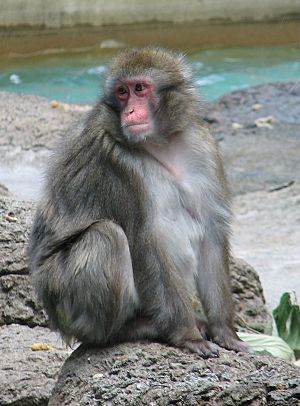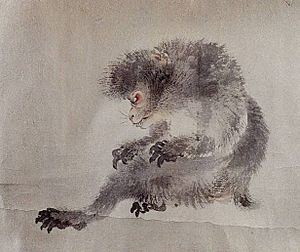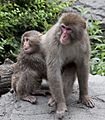Japanese macaque facts for kids
Quick facts for kids Japanese macaque |
|
|---|---|
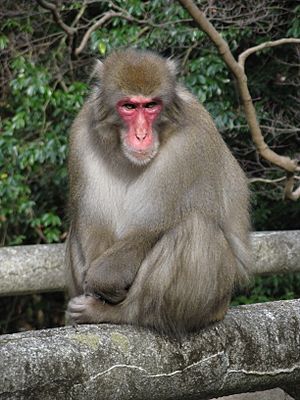 |
|
| Conservation status | |
| Scientific classification | |
| Kingdom: | |
| Class: | |
| Order: | |
| Family: | |
| Genus: | |
| Binomial name | |
| Macaca fuscata |
|
| Subspecies | |
|
Macaca fuscata fuscata |
|
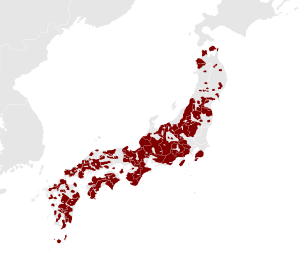 |
|
| Japanese macaque range | |
The Japanese Macaque (Macaca fuscata), also known as the Snow Monkey, is a type of monkey that lives in Japan. They are famous because some of them live in very cold, snowy places, which is unusual for monkeys! They are the only kind of monkey found in Japan.
The Japanese Macaque is very smart. It is the only animal other than humans and raccoons that is known to wash its food before eating it.
Contents
Description
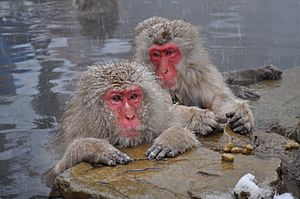
Japanese macaques have thick fur that helps them stay warm, especially in snowy regions. Their fur gets thicker when it's cold. They have distinctive pink or red faces and bottoms, and their tails are quite short, more like little stumps.
Males and females look a bit different in size. Males are usually taller and weigh more than females. On average, males weigh about 11.3 kilograms (25 pounds) and are about 57 centimeters (22.4 inches) tall, while females weigh about 8.4 kilograms (19 pounds) and are about 52.3 centimeters (20.6 inches) tall.
These monkeys are good at moving around both on the ground and in trees. They usually walk on all fours.
Behavior
Japanese macaques are active during the day. Their daily activities include resting, traveling, feeding, and grooming. How they spend their day can change depending on the season and how cold it is. In winter, they might spend more time feeding to build up energy and huddle together to stay warm when sleeping.
Grooming is a very important activity for Japanese macaques. They groom each other to keep clean and also to build and maintain social relationships within the troop. Females often groom their relatives and other females to keep the group friendly and connected.
Some Japanese macaques, particularly those at Jigokudani Monkey Park, are famous for bathing in hot springs during the winter. This behavior started when people encouraged them to use the springs to help reduce conflicts over food. Bathing in the hot springs helps them stay warm and has even been linked to lower stress levels in the winter.
In snowy areas, macaques have been observed rolling snowballs, seemingly just for fun!
Parenting
Macaque mothers take great care of their babies. When a baby is born, it has dark-brown fur. For the first few weeks, the mother carries the infant on her belly, and then later on her back. Babies start trying solid food around five to six weeks old and can find food on their own by about seven weeks. Mothers continue to carry their infants for over a year. Sometimes, other females in the group, especially those without their own babies, might help care for the infants. In some groups, older males have also been seen protecting, grooming, and carrying infants. Babies become fully mobile within a few months and are usually fully weaned (stop drinking mother's milk) by about 18 months old.
Social Life
Japanese macaques are very social animals and live in groups called troops. These troops have interesting social structures.
Within a troop, there is a clear ranking system. Some monkeys are more dominant than others. The social rank within the group is often passed down through the mother's side of the family. Females usually stay in the group they were born into for their whole lives.
Unlike females, male macaques usually leave their birth group before they are fully grown. They might join other groups or spend time alone before finding a new troop. Males also have a dominance hierarchy, with one male often being the "alpha" or top-ranking male. This alpha position can change over time.
Communication
Japanese macaques use different sounds to communicate. They make "coo" sounds when they are feeding or moving, which helps the group stay together and friendly. They also use "girney" calls, sometimes before grooming or to calm things down during disagreements. They have special alarm calls to warn others about danger.
Learning
Japanese macaques are known for being intelligent and have even shown signs of cultural behaviors that are passed down through the group.
A famous example comes from Koshima Island. Researchers left sweet potatoes on the beach. A young female macaque named Imo started washing the sand off her sweet potatoes in the river. Later, she began dipping her clean potatoes in the salty seawater, perhaps to season them. Other monkeys in her troop started copying her, and this behavior spread, becoming a tradition in that group. She also figured out how to separate wheat from soil by throwing it in the water and scooping up the wheat that floated. These examples show how they can learn new things and pass them on.
Diet
Japanese macaques are omnivores, meaning they eat both plants and sometimes animals like insects. Their diet is very varied and includes over 200 different types of plants, as well as bark and even soil. What they eat can change with the seasons. For example, on Yakushima Island, they eat a lot of fruit in the summer and herbs in the winter. In colder northern areas, they focus on eating fruits and nuts in the autumn to store fat for the winter when food is harder to find. If their favorite foods aren't available, they might dig up roots or eat fish.
Distribution and habitat
The Japanese macaque holds the record for being the non-human primate that lives the farthest north in the world. They are found on the main islands of Japan: Honshu, Shikoku, and Kyushu, as well as some smaller islands. They live in many different kinds of forests, from warmer forests in the south to colder, mountainous forests in the north where it snows heavily.
Relationship with humans
For a long time, human activities like cutting down forests and hunting affected macaque populations. However, since hunting was banned in 1947 and forests have regrown in some areas, the macaque population has increased significantly. Also, their natural predators, like the Japanese wolf, are no longer present.
Because there are more macaques now, and human areas are expanding, the monkeys sometimes come into conflict with people. They can become agricultural pests by eating crops. Farmers have to use special fences to protect their fields. Sometimes, when macaque populations get too large or cause significant damage, wildlife managers may need to control their numbers. This is a complex issue that involves balancing the needs of both humans and the monkeys. Sometimes, macaques also wander into towns and cities, which can cause problems.
Quick Facts
- Scientific Name: Macaca fuscata
- Other Name: Snow Monkey
- Where They Live: Japan (Honshu, Shikoku, Kyushu, and some smaller islands), and a group in Texas, USA.
- Habitat: Forests, from warm subtropical areas to cold, snowy mountains.
- Diet: Omnivorous (eat plants, insects, and sometimes other things).
- Size: Males are generally larger and heavier than females.
- Appearance: Brownish-grey fur, pinkish-red faces, and short tails.
- Lifespan: Up to 32 years for females, up to 28 years for males in the wild.
Interesting facts about the Japanese macaque
- Japanese macaques have been important in Japanese culture for centuries. They appear in Shinto beliefs and folklore. The famous carving of the "three wise monkeys" ("see no evil, hear no evil, speak no evil") is found at a shrine in Nikko.
- Recent studies suggest that macaque groups in different areas might have slightly different pitches in their calls, similar to how humans have different accents.
- These monkeys are surprisingly good swimmers and can swim for quite a distance.
- A group of Japanese macaques was moved from Kyoto, Japan, to a special area in Texas, USA, in the 1970s. They had to adapt to a very different environment there, learning to find new foods like mesquite beans and cactus fruits and avoid different predators. This group has grown and continues to live in Texas today.
- In a very interesting case documented at Takasakiyama Natural Zoological Garden, a female macaque named Yakei became the leader of her large troop in 2021. This was unusual because male macaques typically hold the top leadership positions. Yakei, who was nine years old at the time, challenged and displaced the dominant males and even her own high-ranking mother to take the alpha position. She has remained the leader, showing that female leadership is possible in their society, even if it's rare.
Images for kids
-
The famous Japanese warrior Kato Kiyomasa was depicted with his macaque who holds a writing brush, by Tsukioka Yoshitoshi (1883)
-
A macaque eating yakiimo
See also
 In Spanish: Macaco japonés para niños
In Spanish: Macaco japonés para niños



